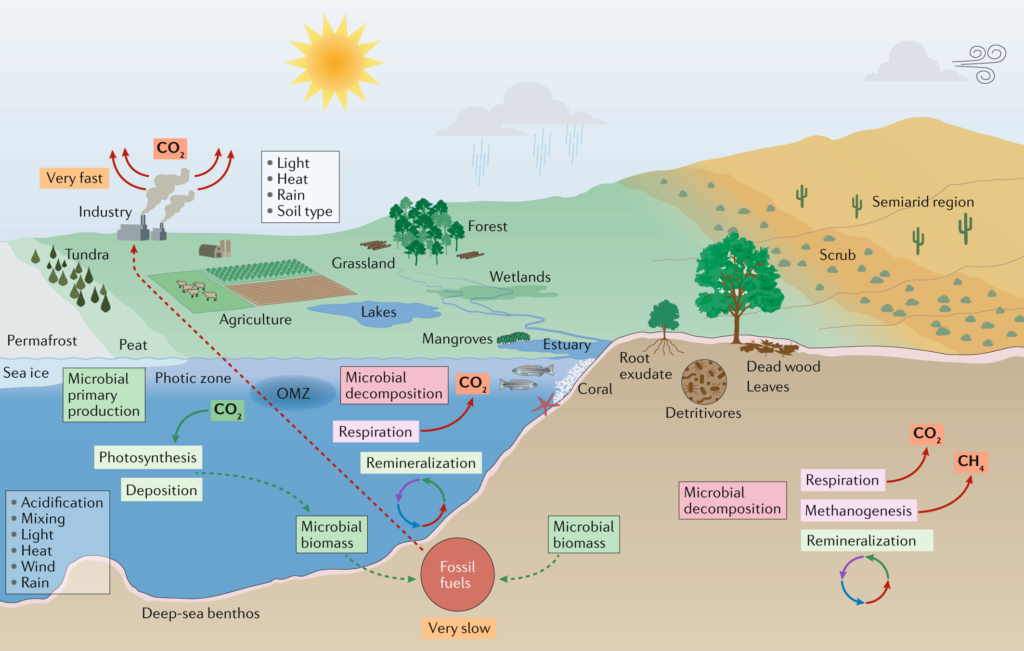Climate change is one of the most pressing challenges facing our planet today, with rising global temperatures and greenhouse gas emissions threatening ecosystems and human well-being. While the impact of climate change is undeniable, a recent study sheds light on a fascinating aspect that offers hope for mitigating its effects. Microorganisms, the tiniest inhabitants of Earth, possess the remarkable ability to adapt and thrive in changing environmental conditions. Harnessing this unique capability may prove instrumental in reducing global warming and promoting a more sustainable future.
Microbial Adaptation and Climate Change:
Microorganisms, including bacteria, fungi, and algae, are abundant in every corner of the planet. Despite their minuscule size, they play critical roles in various ecological processes. As temperatures rise and climates shift, these microorganisms demonstrate their resilience by adapting to new conditions and even assisting in carbon sequestration.
- Carbon Cycling: Microbes participate in carbon cycling, a vital process in the global carbon balance. Some microorganisms facilitate the decomposition of organic matter, releasing carbon dioxide into the atmosphere. Others, like certain soil bacteria and algae, capture and store carbon through photosynthesis. Understanding and harnessing these mechanisms can help control carbon emissions.
- Methane-Eating Microbes: Methane, a potent greenhouse gas, is released during natural processes and human activities. Methanotrophic bacteria possess the unique ability to consume methane, converting it into less harmful substances. Research is underway to explore how these microbes can be harnessed to reduce methane emissions from landfills, agriculture, and natural gas operations.
- Algae and Bioenergy: Certain microalgae are efficient at converting carbon dioxide into biomass through photosynthesis. By cultivating these algae, researchers are exploring their potential as a renewable source of bioenergy while simultaneously reducing atmospheric carbon dioxide levels.
Microbial Engineering for Climate Solutions:
Scientists are now investigating ways to enhance microorganisms’ potential as climate change warriors. Microbial engineering involves modifying microbial genomes to optimize their abilities for carbon capture, greenhouse gas reduction, and other environmentally beneficial processes.
- Synthetic Biology: Synthetic biology techniques enable scientists to design and engineer microorganisms to perform specific functions. This includes engineering microbes to break down plastic waste, clean up oil spills, and sequester carbon more efficiently.
- Soil Microbiome Management: The soil microbiome, teeming with beneficial microorganisms, plays a vital role in nutrient cycling and carbon storage. By managing soil microbiomes, farmers and land managers can promote carbon sequestration and enhance soil health, mitigating the effects of climate change.
Conclusion:
Microorganisms’ adaptive capabilities offer a glimmer of hope amidst the challenges of climate change. As scientists delve deeper into understanding the intricate interactions between microorganisms and the environment, the potential for microbial engineering and management becomes increasingly evident. By harnessing the power of these tiny inhabitants, we can develop innovative solutions to combat global warming and create a more sustainable future.
However, it is essential to recognize that microorganisms alone cannot be the sole solution to climate change. To address this complex issue effectively, a multifaceted approach that encompasses global cooperation, sustainable practices, and the transition to cleaner energy sources is necessary. By combining the power of microorganisms with broader efforts, we can strive towards a world where the impact of climate change is minimized, and the health of our planet is preserved for generations to come.


